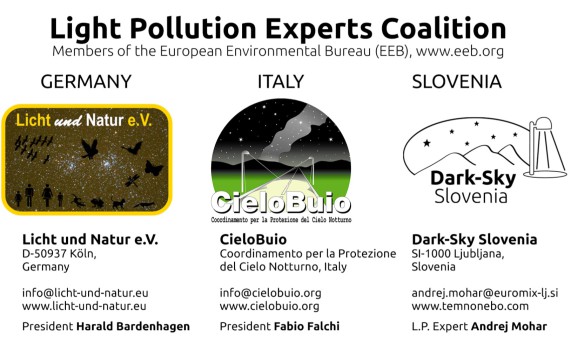Standards of Low Impact Lighting (LIL)
1. Energy Consumption
Lighting installation can only be qualified as Low Impact Lighting (LIL) if the target energy consumption in a given municipality per capita per year is lower than 15 kWh. This target value includes all losses on cables and also includes all outdoor public illumination (also facade illumination).
2. Blue-Light Content
Correlated Colour Temperature (CCT) of all luminaires must be equal or lower than 2200 K AND must emit under 500 nm energy flux lower than 6% of the total emitted in the entire visible range. In case of an average illumination level below 5 lx it is allowed to use luminaires with CCT from 2200 K up to 2700 K AND energy flux must be lower than 10% of the total emitted in the entire visible range under 500 nm.
3. Upward Light Output Ratio
The Upward Light Output Ratio (ULOR) of a luminaire must be 0.0%. This needs to be valid during the whole lifetime of the luminaire and also when the luminaire is dirty.
4. Prohibitive Rules
It is not allowed to illuminate
- highways and motorways, including their exits and junctions,
- roads allowed for motorized traffic only,
- roads outside settlements,
- junctions and roundabouts outside settlements.
5. Pole Distance
The distance between poles must be at least 3.7 times greater than the pole height.
6. Maximum Luminance
The luminance of the main roads in cities and towns is not allowed to exceed 0.5 cd/m2.
7. Curfew
For all luminaires there must be implemented a curfew (reduction of power and lumen output in late hours, i.e. outside peak traffic hours) from 100% down to 10% or less in case of adaptive lighting systems, or at least 50% reduction in absence of adaptive lighting.
8. Standards
EN 13201 or national standards which are adopted from EN 13201 must not be implemented.
9. Lifetime
The Lifetime (MTBF-mean time between failure) of luminaires must be at least 100.000 hours or 25 years.
10. Luminaire Efficacy
The minimum efficacy of a luminaire at full power needs to be at least:
- luminaire below 1900K (like amber) 50 lm/W
- luminaire below 2200K (like pc-amber) 95 lm/W
- luminaire between 2200K and 2700K 100 lm/W
A lower luminaire efficacy is allowed when the pole-distance: pole-height ratio exceeds 6:1 or when a mechanical shielding is necessary in order to reduce unwanted illumination of nearby houses or natural environment.
11. Illumination Utilisation Factor
At least 70 % of the lumen output must target the road/street/walking area. Lower utilisation factor down to 40 % is allowed in following cases:
- narrow paved bicycle path
- narrow paved pedestrian path
12. Protection of People
To secure the basic human right to sleep in a dark environment, which is important for good sleep, the maximum allowed illumination on windows after 22:00 o’clock (standard time) is:
- 0.01 lx when window is at least 20 m from illuminated public place
- 0.02 lx when window is at least 10 m from illuminated public place
- 0.05 lx when window is at least 5 m from illuminated public place
- 0.10 lx when window is at least 2 m from illuminated public place
- 0.50 lx when window is less than 2 m from illuminated public place
Parking places on highways and other roads which are used for car drivers and truck drivers and where drivers may sleep in their vehicles may be illuminated but with the following limitations:
- CCT must be below 2200 K
- Illumination levels must be below 1 lx

